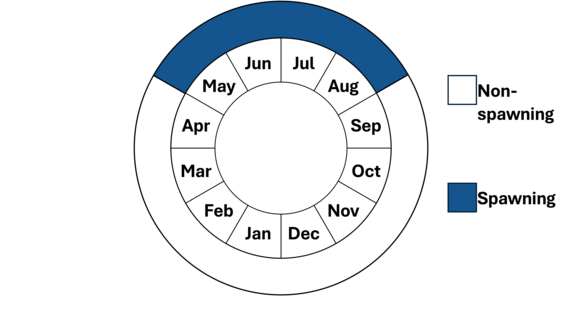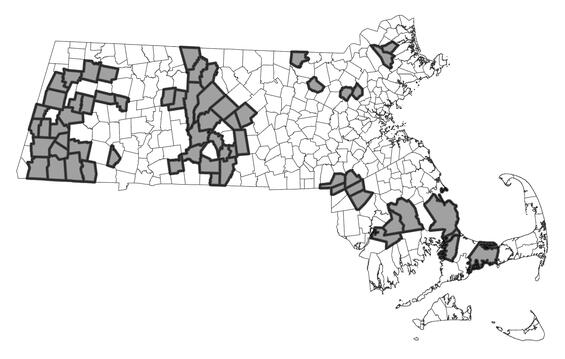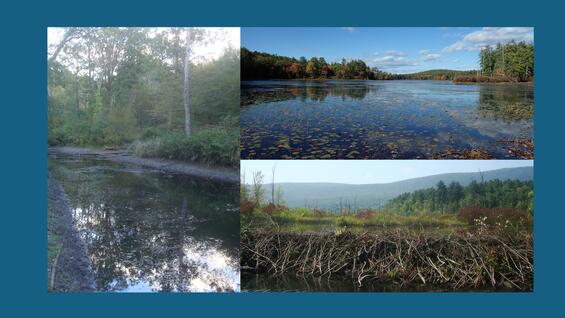- Scientific name: Notropis bifrenatus
- Species of Greatest Conservation Need (MA State Wildlife Action Plan)
- Special Concern (MA Endangered Species Act)
Description
Bridle shiner (Notropis bifrenatus)
The bridle shiner is a small minnow (≤ 70 mm; 2.75 in) that is straw colored with a distinct dark lateral band that starts at the tip of the snout, through the eye, and ends in a spot at the base of the caudal fin. This minnow has a large eye and a somewhat pointed, slightly subterminal mouth. The scales on the sides of the body have distinct dark outlines. The breast is usually 90-100% scaled, and the belly is fully scaled. The lateral line is generally incomplete. Bridle shiners have 32-36 lateral line scales. They generally have 8 dorsal rays, 7 anal rays, 8 pelvic rays, and 12 pectoral rays. They have a silvery and lightly speckled peritoneum (lining of the body cavity). Mature males become more yellow laterally during the spawning season.
Other small minnow species and small creek chubsuckers (Erimyzon oblongus) with black lateral bands can be confused for bridle shiner. However, the combination of the bridle shiner’s large black-outlined scales laterally and on the dorsum, big eye with lateral black band running through, and terminal to subterminal mouth distinguishes this species.
Life cycle and behavior

The bridle shiner matures at a year and only lives for about 2-3 years. Spawning occurs during the day from late May to the end of July but may occur as late as August. Spawning sites are generally located in water depths of 0.6 m (~2 ft) in clearings surrounded by dense submerged vegetation or macroalgae, such as Ceratophyllum, Myriophyllum or Chara. Eggs sink and adhere to vegetation. Young of the year remain in vegetation until late July when they begin to school with other young of the year bridle shiners, and by August they join adult schools. Within lentic and particularly in stream systems, bridle shiner is patchily distributed, tied to low-energy habitats that support suitable submerged aquatic vegetation beds for predator refuge and food resources. Bridle shiners show limited dispersal amongst occupied habitat patches within a stream system (e.g., <100m;110 yds) with only a few individuals that may disperse longer distances (Jensen 2012). Bridle shiners are visual predators and feed only during the day. They feed in the benthos, water column or around aquatic vegetation. Their diet mainly consists of invertebrates, such as Chironomidae, Cladocera, and Copepoda. Bridle shiners are weak swimmers and are prey for pickerel, bass, and perch species.
Bridle shiner schooling and foraging over a bed of Ceratophyllum.
Distribution and abundance
The bridle shiner range extends from South Carolina north along the Atlantic coast to New England and into Quebec and Ontario. The species occurs in all New England states. In Massachusetts, the bridle shiner occurs in most major watersheds including the Hoosic, Housatonic, Westfield, Deerfield, Middle Connecticut, Millers, Chicopee, Quinebaug, Nashua, Concord, Shawsheen, Ipswich, Charles, Taunton, and Cape Cod watersheds.
Bridle shiner declines have been documented across much of its range including Maine and Connecticut, and particularly in more southern states. Declines in New England and in Massachusetts are likely due to habitat loss and water quality degradation deriving from stream channelization, increased watershed impervious cover, increased sedimentation, agricultural runoff, and pollutant discharge among other reasons. However, recent efforts in Maine (Katz et al. 2024) and Connecticut (Pregler et al. 2015) found bridle shiner declines are not as severe as once indicated and can be partly attributed to the species' low detection rate from single-site visit samples and sampling gear bias against electrofishing. Although bridle shiner detection rates have not been quantified in Massachusetts, this situation likely applies to several occurrences in Massachusetts. Snorkel and seine surveys in the past 15 years have rediscovered bridle shiner at several historic sites and in abundance. However, true declines of bridle shiner are likely especially in eastern MA watersheds where watershed impervious cover and stream and pond habitat alteration are more prevalent.

Distribution in Massachusetts. 2000-2025. Based on records in the Natural Heritage Database.
Habitat
Bridle shiners are found in low-energy, clearwater habitats including low-gradient streams, slack-water habitats (e.g., backwaters) in streams, beaver ponds, human impoundments, and lakes and ponds. Substrates are predominantly finer materials including sand, silt, and organic matter. Bridle shiner is strongly associated with patches of moderate cover of submerged aquatic vegetation and adjacent open areas and are often observed at shallower depths. The species may prefer sites with high coverage of submerged aquatic vegetation along the bottom 25 cm (9.8 in) and of vegetation with feather-like leaves such as Ceratophyllum. Based on a Connecticut effort, bridle shiners are more likely to occupy lake and pond habitats compared to streams, watersheds with higher forest cover, and at sites located higher in watersheds (Pregler et al. 2019). These findings likely apply to Massachusetts.
Healthy habitats are vital for supporting native wildlife and plants. Explore habitats and learn about conservation and restoration in Massachusetts.

Low gradient stream habitat (left), beaver pond (top right), and pond habitat (bottom right) suitable for bridle shiner.
Threats
Threats to bridle shiner in Massachusetts include increased erosion and fine sedimentation that increase turbidity, streamflow alterations, water drawdowns of lakes and ponds, accelerated pond eutrophication, increased watershed impervious cover, agricultural and road runoff, improper use of herbicides, and invasive aquatic plant species. Increases in water turbidity reduce physiological functions (Gray et al. 2016) and alter swimming behavior (Gray et al. 2014) that may increase predation risk and reduce foraging activity. Changes in flow, particularly increased flows, may wash out suitable bridle shiner habitat and bridle shiners themselves. Loss of or reduced availability to suitable submerged aquatic vegetation beds from improper use of herbicides, water-level drawdowns, invasive plant species monocultures can negatively impact bridle shiner spawning and increase exposure to predators.
Conservation
Bridle shiner captured by seine.
Survey and monitoring
Single-visit fish community assessments using backpack or boat electrofishing are likely insufficient to detect bridle shiner in most ambient water quality conditions. Bridle shiners are most likely to be detected with repeated visits with seine or mask and snorkel sampling in pre-defined habitat, i.e., submerged aquatic vegetation beds and/or slack-water mesohabitats. Further, bridle shiners are more likely to be detected later in their growing season, particularly in August and September. Snorkel surveys have proved to be particularly efficient in redocumenting bridle shiner in difficult to traverse low gradient wetland stream habitat and pondshore vegetation beds.
Management
Management of bridle shiner is focused on habitat protection and restoration. Protective measures are implemented in lake and pond habitat to avoid and minimize potential adverse impacts from lake management activities including herbicide application and water-level drawdowns. Protection of vegetated riparian zones and watersheds is critical for maintaining high water quality and reduction in altered streamflows.
Research needs
Research effort is needed to perform long-term monitoring at prioritized sites to detect temporal trends in population size, survey historical and new sites with sufficient sampling methods to determine accurate species occupancy (e.g., eDNA, seine, snorkel), determine spawning sites and high-quality habitat patches particularly in stream systems where bridle shiner can complete its full life cycle, and determine physiological tolerances to new and commonly applied herbicides, algaecides, and nutrient reduction agents.
References
Gray, S.M., F.M.E. Bieber, L.H. McDonnell, L.J. Chapman, N.E. Mandrak. 2014. Experimental evidence for species-specific response to turbidity in imperilled fishes. Aquatic Conservation: Marine and Freshwater Ecosystems 24(4):546-560.
Gray, S.M., L.H. McDonnell, N.E. Mandrak, L.J. Chapman. 2016. Species-specific effects of turbidity on the physiology of imperiled blackline shiners Notropis spp. in the Laurentian Great Lakes. Endangered Species Research 31:271-277.
Jensen, T. 2012. Movement, habitat use, and detection probability of bridle shiner estimated by patch occupancy modeling in a Connecticut watershed. University of Connecticut, M.S. thesis, 84 pp.
Jensen T., and J.C. Vokoun. 2013. Using multistate occupancy estimation to model habitat use in difficult-to-sample watersheds: bridle shiner in a low-gradient swampy stream. Canadian Journal of Fish and Aquatic Sciences 70:1429-1437.
Hartel, K.E., Halliwell, D.B., Launer, A.E. Inland Fishes of Massachusetts. Lincoln, MA: Massachusetts Audubon Society, 2002.
Pregler, K.C., N. Hagstrom, E.T. Schultz, J.C. Vokoun. 2019. Landscape factors predict local extirpation in an imperiled minnow species, the bridle shiner (Notropis bifrenatus). Aquatic Conservation: Marine and Freshwater Ecosystems 29(8):1227-1237.
Pregler, K.C., J.C. Vokoun, T. Jensen, N. Hagstrom. 2015. Using multimethod occupancy estimation models to quantify gear differences in detection probabilities: is backpack electrofishing missing occurrences for a species of concern? Transactions of the American Fisheries Society 144(1):89-95.
Contact
| Date published: | April 16, 2025 |
|---|